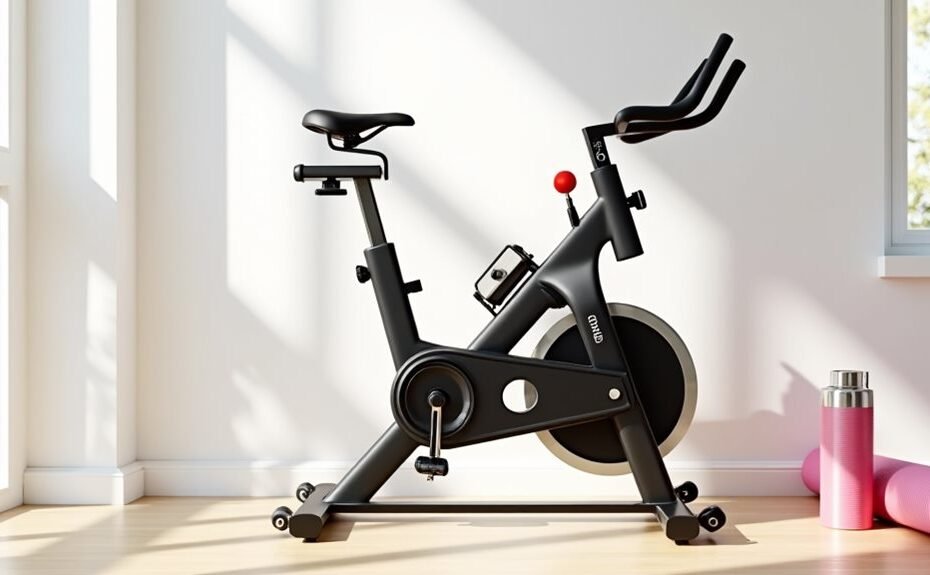I've learned through years of coaching cyclists that recovery isn't just about taking time off – it's an active process that can make or break your performance goals. Whether you're training for your first century ride or pushing your limits in virtual racing, the way you approach recovery directly impacts your ability to bounce back stronger. As a static bike enthusiast, I'll share my proven strategies for maximizing recovery time, from setting up the perfect recovery zone to timing your sessions for best results. There's more to smart recovery than most cyclists realize, and I'm about to show you why.
Key Takeaways
- Keep recovery rides in Zone 1, maintaining heart rate below 81% of lactate threshold for optimal muscle repair.
- Start with 15-20 minutes of easy spinning at high cadence while maintaining relaxed form and neutral spine.
- Consume 1-1.2g of carbs per kilogram bodyweight plus protein within 30-60 minutes post-ride for muscle recovery.
- Schedule recovery sessions between tough workouts, using indoor trainers for controlled, consistent intensity.
- Monitor progress through heart rate variability, power output tracking, and keeping detailed workout journals.
Why Recovery Rides Matter
While many cyclists focus solely on high-intensity workouts, recovery rides play an important role in building endurance and maintaining peak performance. I've seen athletes transform their training by incorporating these deceptively simple sessions, which can boost leg endurance by up to 90% when done correctly. Trust me, there's real science behind riding in a pre-fatigued state. Riding solo is essential to maintain the proper easy pace. Air resistance technology can actually enhance the effectiveness of these recovery rides by providing smooth, consistent pedaling.
Keeping sessions to thirty to sixty minutes is ideal for maximum benefit. Here's what you're missing if you skip recovery rides: They're your secret weapon for teaching your body to maintain proper form when you're tired – essential for race day performance. I'm talking about enhanced muscle recruitment and smoother pedaling without the punishment of hard sessions. Plus, you'll get the mental boost you need to push through fatigue when it counts.
Don't mistake these for lazy rides. I want you to approach them strategically – keeping intensity at 30-50% of your FTP. You'll feel better physically and mentally, and your metabolism keeps humming along. It's like hitting the reset button on your training cycle. Think of it as active recovery that primes your body for those significant high-intensity sessions ahead.
Setting Up Your Recovery Zone
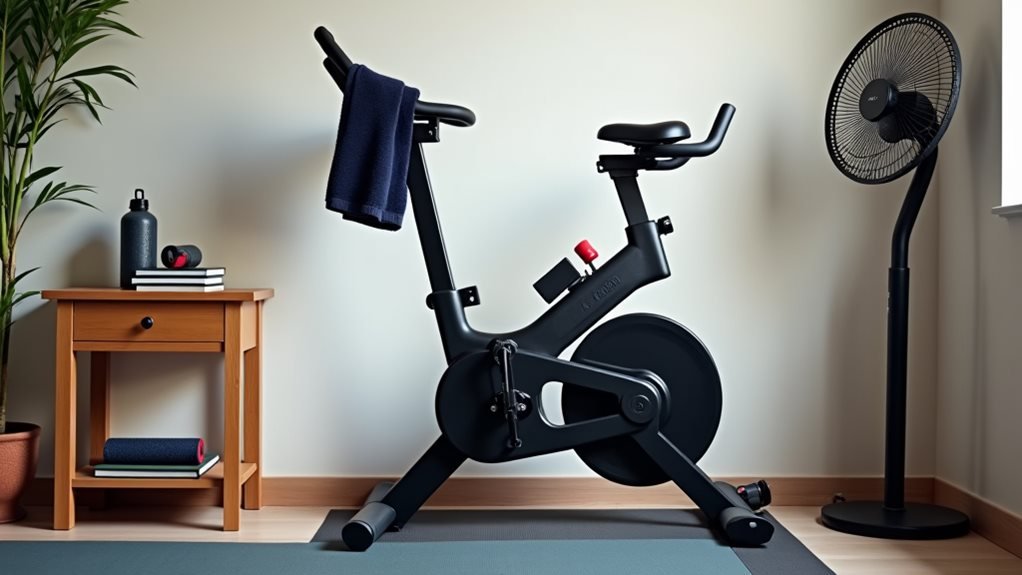
Since establishing proper recovery zones requires precision, let me walk you through setting up your ideal training environment. I'll tell you straight – your indoor trainer's about to become your new best friend. It's your controlled laboratory for perfect recovery sessions. Understanding Zone 1 training helps promote muscular adaptations and proper aerobic metabolism.
First, let's nail your numbers. Take 180, subtract your age – that's your MAF heart rate. You'll want to stay below 81% of your lactate threshold during recovery rides. Don't have a power meter? No problem. Focus on keeping your heart rate between 60-64% of your threshold heart rate. I'm talking turtle-pace here, folks.
Set up your bike trainer in a cool, comfortable space. Position your seat at hip height – your back will thank me later. A heart rate monitor can provide accurate feedback during your session.
If you've got a smart trainer, even better. Program it to keep you honest with a target intensity factor of 0.40. Keep your cadence above 65 RPM, but don't push it. Remember, we're aiming for 40-60 minutes of pure, glorious recovery. Any longer and you're just accumulating fatigue. Any shorter and you're wasting your time.
Timing Your Recovery Sessions
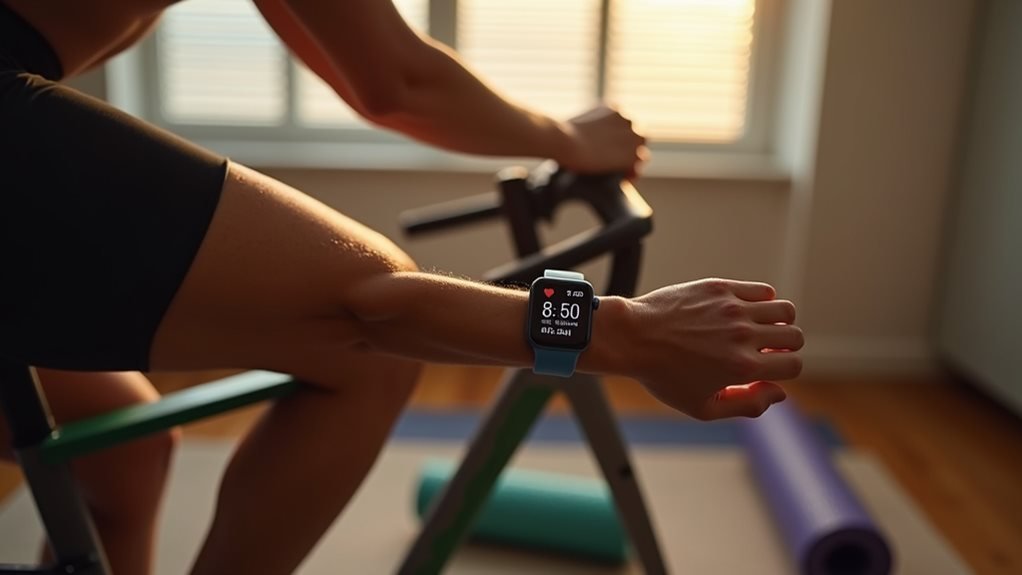
The art of timing your recovery sessions can make or break your training progress. I'll tell you straight – your body needs strategic downtime between hard efforts, and I'm here to guarantee you nail it. Let's map out your perfect recovery schedule with zero room for guesswork. Low-impact exercise like cycling can be particularly effective for active recovery between intense workouts.
| Timing Type | Best Practice | Warning Signs |
|---|---|---|
| Mid-Week | Place between hard workouts | Lingering fatigue means extend recovery |
| Pre-Weekend | Schedule Friday for weekend readiness | Skip if feeling fresh and ready |
| Recovery Week | Multiple easy sessions | Watch for overtraining signals |
Look, I'm not here to sugarcoat it – you need to be strict about your recovery timing. If you're planning a monster weekend ride, I want you doing a recovery session on Friday. Period. For mid-week sessions, sandwich them between your tough workouts, and keep them to 40-60 minutes max. Anything less is pointless; anything more defeats the purpose. When the weather turns unpleasant, take it inside – your recovery quality matters more than proving you can brave the elements. And remember: if you're new to this or cross-training heavily, you might need full rest days instead. Trust me on this. If your planned workout feels too demanding on a particular day, a recovery ride as substitute can help maintain training consistency while preventing overexertion. Your fitness level and age significantly influence how much rest you need, so monitor fatigue levels carefully to determine your optimal recovery timing.
Nutrition for Optimal Recovery
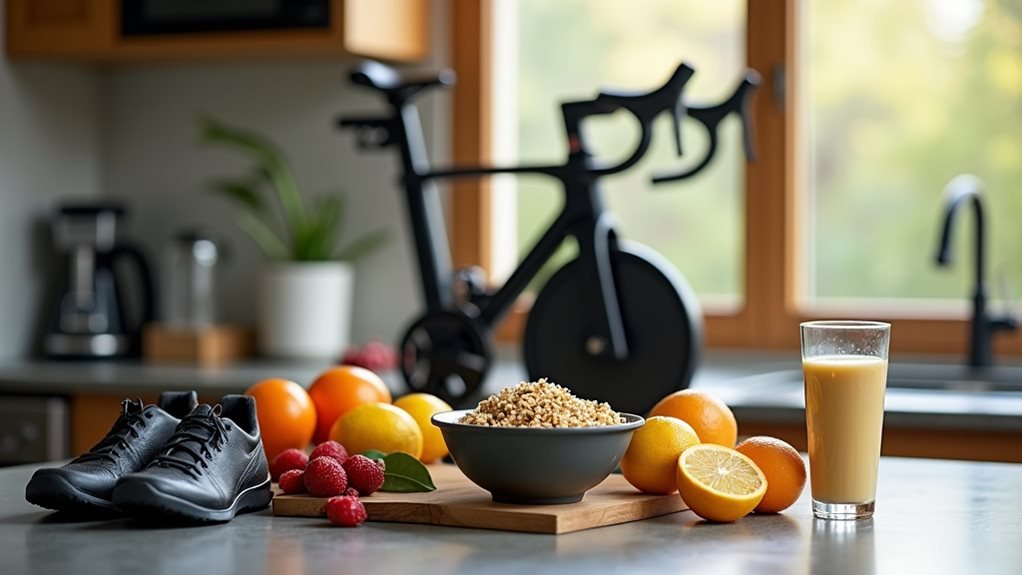
Recovery nutrition isn't just about eating – it's a precise science of timing and portions that can supercharge your bounce-back after rides.
I'll tell you straight: within 30-60 minutes post-ride, you need to nail that golden window for both carbs and protein. Think 1-1.2g of carbs per kilogram of body weight, with a 3:1 carb-to-protein ratio. A balanced recovery meal should include healthy fats alongside your protein and carbs to optimize nutrient absorption.
Listen up – your muscles are literally begging for glycogen replenishment right now. Skip this, and you're setting yourself up for sluggish performance and unnecessary soreness. If healthier options aren't available, even fast food can help kickstart recovery. Consider adding collagen protein powder to boost your recovery nutrition strategy.
I want you loading up on easy-digest carbs like sweet potatoes and bananas, paired with quality protein sources. And no, you can't just dump 100g of protein into your system – your body maxes out at about 30g at a time.
Don't forget the hydration equation. You're not just losing water during rides; you're dumping electrolytes too. Keep drinking throughout the day, and yes, that means more than just plain water.
Hit those electrolyte-rich foods and drinks, especially if you've been sweating buckets on that bike. Trust me, your tomorrow-self will thank you.
Recovery Methods Beyond the Bike
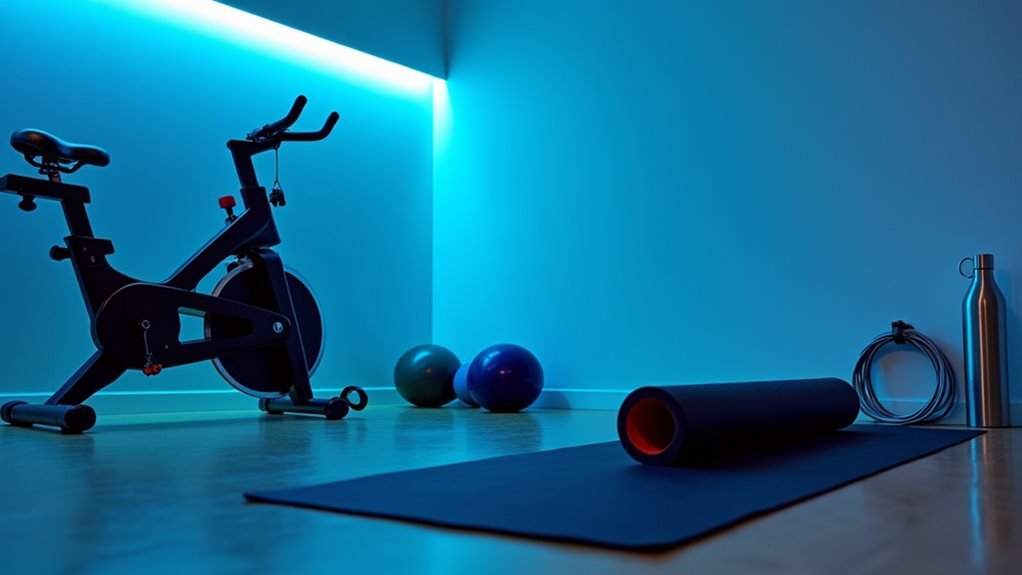
Beyond nutrition, three powerful recovery methods can transform your post-ride bounce-back. First, I'll insist you master active recovery – think gentle walking, swimming, or yoga. I'm not suggesting a marathon here; just enough movement to keep blood flowing and muscles happy. Trust me, your legs will thank you. Regular sessions help restore muscle strength while minimizing stress on your joints. Combining active recovery with low-impact exercises like swimming and yoga aids in rehabilitation and injury prevention.
Next up: hydration and electrolytes. I don't care how short your ride was – you need to replenish. Drink water consistently, and don't skimp on those electrolyte supplements. Your heart needs proper hydration to pump blood efficiently, which speeds up recovery. Pro tip: Natural ingredients absorb better than synthetic ones.
Monitoring Your Recovery Progress
Your body's signals provide the clearest roadmap for recovery progress. I'll show you how to decode these signals through key metrics you can't afford to ignore.
Track your heart rate variability (HRV) religiously – it's your body's stress detector and recovery gauge rolled into one. Monitor your power output in watts; it doesn't lie about your fitness gains.
Let's get methodical. Start a workout journal – now. Record your RPE (Rate of Perceived Exertion) after each session, along with interval durations and resistance levels.
I want you measuring range of motion improvements, particularly if you're bouncing back from surgery. Compare today's numbers with last week's – that's how you'll spot trends.
Don't wing it with your recovery program. Adjust resistance levels based on your progress, not your ego. Customize your work-to-rest ratios; they're not set in stone.
When you're tracking correctly, you'll know exactly when to push harder and when to dial it back. Remember: data drives decisions. If you're not measuring, you're just guessing – and guessing won't get you back to peak performance.
Building Your Recovery Routine
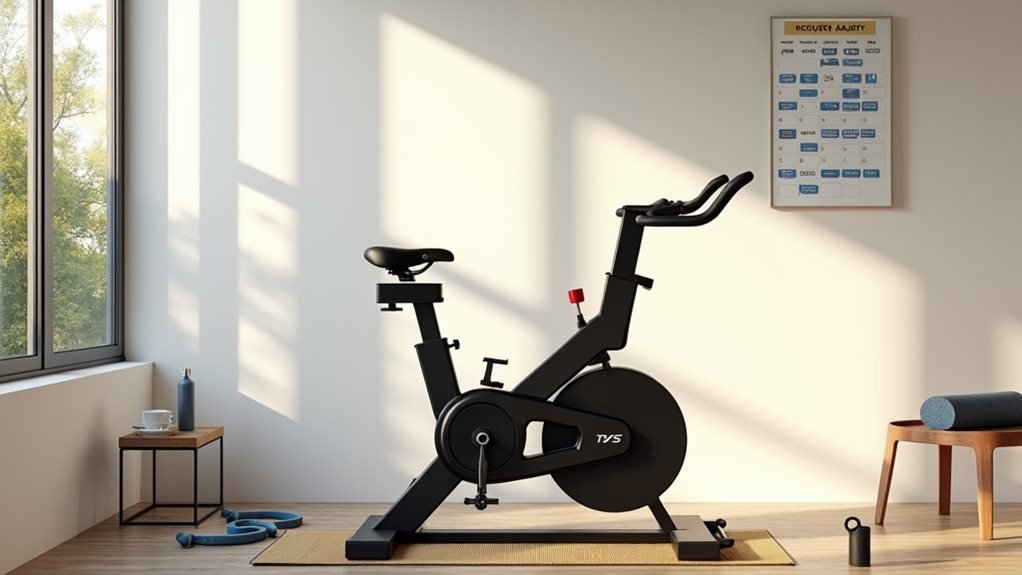
In light of your recovery goals, building a structured routine demands careful attention to every component. I'll help you create a foolproof plan that maximizes your recovery potential while preventing the classic mistakes I've seen countless times.
Start with 15-20 minutes of easy spinning at a high cadence – trust me, it's more effective than you'd think. Keep those shoulders relaxed and your spine neutral. I don't care how tired you are; proper form isn't negotiable. Your knees should never lock out – maintain that slight bend.
Mix in some single-leg drills (yes, they're awkward at first) to smooth out those dead spots in your pedal stroke.
And here's the kicker: fuel up within 30 minutes post-ride. I'm talking protein and carbs – your muscles are literally begging for it.
For hydration, don't overthink it. A balanced recovery drink will do the trick, but plain water and a banana can work just as well. Remember, this isn't rocket science – it's about consistency and listening to your body's signals.
Frequently Asked Questions
Can I Do Recovery Rides if I Have a Minor Injury?
Like a gentle breeze, recovery rides can help heal minor injuries. I recommend you start with short, low-impact sessions, but always consult your healthcare provider before beginning.
Does Weather or Indoor Temperature Affect Optimal Recovery Intensity?
Yes, temperature and weather greatly affect recovery intensity. I suggest riding indoors at 68-72°F for best conditions, as extreme temperatures and weather can increase stress on your body during recovery.
Should Recovery Rides Be Different for Morning Versus Evening Sessions?
I recommend keeping morning and evening recovery rides similar in intensity, but I'd schedule evening rides at least 2-3 hours before bedtime to avoid sleep disruption.
How Do Medications Impact Recommended Recovery Ride Duration and Intensity?
I recommend shortening your recovery rides and reducing intensity if you're on medications that affect stamina, heart rate, or coordination. Always check with your doctor for personalized adjustments.
Can I Combine Recovery Rides With Meditation or Breathwork Exercises?
Who knew zen and cycling were such perfect partners? I absolutely recommend combining recovery rides with meditation – focus on your breath, body sensations, and pedal rhythm for enhanced physical and mental benefits.
